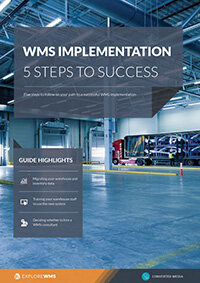If I had known then: steps to successful WMS implementation
Companies should look for ways to be more efficient, pandemic or not. For organizations that have become reliant on imperfect, inefficient systems and processes that have been stitched together, investing in business operations is the number one way to not only streamline those complex ecosystems, but keep up – and even thrive – on the next wave of growth.
In practice, an implementation strategy should invite participants from operations, IT and finance, at a minimum. So, why wouldn’t anyone want to hit the ground running on an investment in the software and infrastructure necessary to improve their company’s operations?
Overcoming mental hurdles early on
From a business operations standpoint, a warehouse management system (WMS) can be a game-changer for distributors. While it may seem harder to justify an investment in software compared to something more tangible like pallet jacks, racking and forklifts, the automation these systems enable has loads of benefits that either directly or indirectly impact a company’s bottom line. For example, a WMS can result in lower labor costs, improved inventory turns, increased shipping accuracy, safer operations, better productivity, more efficient material flow, and performance metrics to see what you’re doing and what’s needed moving forward.
With the ever-rising e-commerce channel, fast and accurate customer deliveries are the norm – thus, stock procurement, storage, retrieval and shipping become critical. The biggest obstacle to making improvements, however, is realizing the warehouse environment has improvement potential. That said, it’s not the last mental hurdle distributors encounter on the track to buying and implementing a WMS.
Some of the most common and enduring hesitations – besides financial concerns – that distributors have expressed before implementing a WMS include:
- “How disruptive is it?”
- “How will my employees adopt this?”
- “What training is involved to make the implementation a success?”
To address these common concerns, let’s take the FAQ approach and address each individually, starting from the top.
Q: “How disruptive is it?”
A: It’s important to consider how much you’re affecting a site by deploying a WMS. Naturally, some amount of disruption is to be expected when introducing change to an environment. And, it can be difficult to overcome the inertia of continuing to do things the way they’ve always been done (e.g., using paper-based systems). Instead of viewing this as an insurmountable obstacle, see it as an opportunity to bring positive change management to task. Employees are used to doing their jobs a certain way, but you might be surprised to find how readily they’ll embrace a new way – especially when it makes it easier for them to do their jobs. Adjusting to the new technology itself, as well as the new overall system it facilitates, requires time in the early stages of implementation in order for workers to reach (then inevitably, exceed) the same level of productivity as before. What I’ve found is that most warehouse workers catch on to the intuitive nature of WMS technology faster than one might expect.
Q: “How will my employees adopt this?”
A: When it comes to WMS implementations, designating a “warehouse champion” is key to employee adoption. This individual will be responsible for successful buy-in and execution of the software tools and process change needed to drive success. Not only does this champion need the earned respect of workers to drive change, they also need the backing of the organization’s management team to embrace the customer service benefits and bottom line impact that a WMS project is expected to achieve. This also gives the WMS project credibility because the initiatives are driven by users with support from operations management, IT, finance and the C-suite.
Q: “What training is involved to make the implementation a success?”
A: In driving a WMS rollout, it is quite tempting to be overly optimistic about the training workers have received on the new software, and the process changes that have been put into place. What I mean by that is, training needs to extend beyond instructions and guidance outlined in a document or conveyed in a classroom-like setting. The most effective learning occurs when tools (e.g., web screens, RF terminals, menu prompts, etc.) can be physically exercised and transactions practiced on the warehouse floor. A team-based approach to the WMS implementation helps ease the transition to the new processes and technologies and bring even the most change-averse workers on board. With a champion’s guidance to supervise this training and proper phasing of the WMS into warehouse operations, the likelihood of success is very high if not certain.
Steps in the final stretch to a successful implementation
Once these early concerns have been conquered, what does it take to cross the finish line for a successful implementation? In this final stretch, there are things you’ll certainly want to square away or get in order before deploying a WMS. For each one you check off the list, the better your odds of ensuring success will be. Ultimately, it’s not as daunting as you might think. Essentially, you’ll want to make sure:
- You have established a realistic schedule for the project rollout with clear assignments noting who will be doing what by when;
- You have buy-in from all stakeholders about the process changes that will be put in place; and
- You are committed to improving your warehouse operations and know why it’s the best investment for the business, right now.
What’s been found during past recessions and heard over the past year is that distributors – often out of necessity – use these slowdowns to prepare for the future. In regard to WMS implementation, the sentiment often echoed by customers is, “If I had known it would have been this successful, I would have done it much sooner.” As Tom Lorenz, executive president at Lorenz & Jones shared, “We installed a WMS to help with our warehouse. Little did we know it would help us get a new customer worth over a million in sales by showing how quickly and accurately we could fill their orders."
Granted, there are times when it could be too disruptive to kick off a WMS deployment due to seasonal variations, staffing concerns, etc, but you won’t know what’s possible or how fast you can realize success until you get your distribution business in the race. Navigate the initial “scariness” that typically delays WMS implementations, and make every step count along the way.
Free white paper

WMS implementation checklist
Over 100 actionable steps to WMS implementation success

Featured white papers
-

-

-

WMS implementation guide
Plan your WMS implementation successfully with this comprehensive guide
Download
Related articles
-

WMS implementation guide including checklist & project plan
A guide to the entire WMS implementation process - from change management planning to go-live
-

Mission-critical features of food lot traceability software
What features of food traceability software will help you during a food recall
-

Why WMS implementations fail
The top problems faced during a WMS implementation

